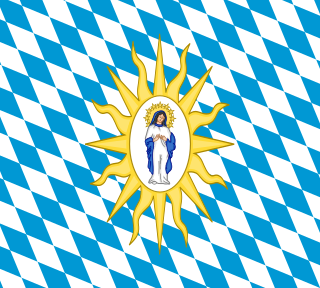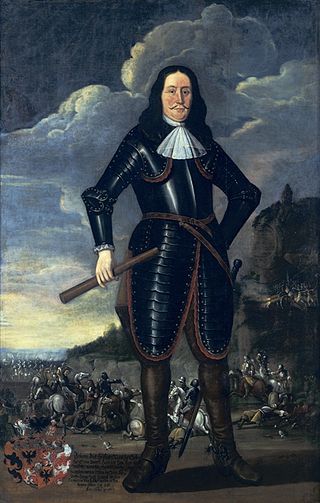Related Research Articles

The Thirty Years' War, from 1618 to 1648, was one of the most destructive conflicts in European history. Fought primarily in Central Europe, an estimated 4.5 to 8 million soldiers and civilians died from the effects of battle, famine, or disease, while parts of Germany reported population declines of over 50%. Related conflicts include the Eighty Years' War, the War of the Mantuan Succession, the Franco-Spanish War, the Torstenson War, the Dutch-Portuguese War, and the Portuguese Restoration War.

Leopold I was Holy Roman Emperor, King of Hungary, Croatia, and Bohemia. The second son of Ferdinand III, Holy Roman Emperor, by his first wife, Maria Anna of Spain, Leopold became heir apparent in 1654 after the death of his elder brother Ferdinand IV. Elected in 1658, Leopold ruled the Holy Roman Empire until his death in 1705, becoming the second longest-ruling Habsburg emperor. He was both a composer and considerable patron of music.

Ferdinand II was Holy Roman Emperor, King of Bohemia, Hungary, and Croatia from 1619 until his death in 1637. He was the son of Archduke Charles II of Inner Austria and Maria of Bavaria, who were devout Catholics. In 1590, when Ferdinand was 11 years old, they sent him to study at the Jesuits' college in Ingolstadt because they wanted to isolate him from the Lutheran nobles. A few months later, his father died, and he inherited Inner Austria–Styria, Carinthia, Carniola and smaller provinces. His cousin, Rudolf II, Holy Roman Emperor, who was the head of the Habsburg family, appointed regents to administer these lands.

Ferdinand III was Archduke of Austria, King of Hungary and Croatia from 1625, King of Bohemia from 1627 and Holy Roman Emperor from 1637 to his death.

Frederick V was the Elector Palatine of the Rhine in the Holy Roman Empire from 1610 to 1623, and reigned as King of Bohemia from 1619 to 1620. He was forced to abdicate both roles, and the brevity of his reign in Bohemia earned him the derisive sobriquet "the Winter King".

The Catholic League was a coalition of Catholic states of the Holy Roman Empire formed 10 July 1609. While initially formed as a confederation to act politically to negotiate issues vis-à-vis the Protestant Union, modelled on the more intransigent ultra-Catholic French Catholic League (1576), it was subsequently concluded as a military alliance "for the defence of the Catholic religion and peace within the Empire".

The Protestant Union, also known as the Evangelical Union, Union of Auhausen, German Union or the Protestant Action Party, was a coalition of Protestant German states. It was formed on 14 May 1608 by Frederick IV, Elector Palatine in order to defend the rights, land and safety of each member. It included both Calvinist and Lutheran states, and dissolved in 1621.

Maximilian I, occasionally called the Great, a member of the House of Wittelsbach, ruled as Duke of Bavaria from 1597. His reign was marked by the Thirty Years' War during which he obtained the title of a prince-elector of the Holy Roman Empire at the 1623 Diet of Regensburg.

Ferdinand Maria was a Wittelsbach ruler of Bavaria and a prince-elector of the Holy Roman Empire from 1651 to 1679. The Elector modernized the army and introduced Bavaria's first government code. Besides encouraging agriculture and industry, he also improved building and restoration works on churches and monasteries since the damage caused during the Thirty Years' War.

The Peace of Prague, dated 30 May 1635 Old Style, was a significant turning point in the Thirty Years' War. Signed by John George I, Elector of Saxony, and Ferdinand II, Holy Roman Emperor, the terms ended Saxony's support for the anti-Imperial coalition led by Sweden.

The Battle of Jankau, also known as Jankov, Jankow, or Jankowitz, took place in central Bohemia on 6 March 1645, near modern Czech town of Jankov. One of the last major battles of the 1618 to 1648 Thirty Years' War, it was fought between Swedish and Imperial armies, each containing around 16,000 men.

The Battle of Zusmarshausen was fought on 17 May 1648 between Bavarian-Imperial forces under von Holzappel and an allied Franco-Swedish army under the command of Carl Gustaf Wrangel and Turenne in the modern Augsburg district of Bavaria, Germany. The allied force emerged victorious, and the Imperial army was only rescued from annihilation by the stubborn rearguard fighting of Raimondo Montecuccoli and his cavalry.

The Treaty of Fontainebleau was signed on 30 May 1631 during the Thirty Years' War, at the Palace of Fontainebleau. It was a pact of mutual assistance between Maximilian I, Elector of Bavaria, and France, for a period of eight years.

The Electorate of Bavaria was a quasi-independent hereditary electorate of the Holy Roman Empire from 1623 to 1806, when it was succeeded by the Kingdom of Bavaria.

The Battle of Herbsthausen, also known as the Battle of Mergentheim, took place near Bad Mergentheim, in the modern German state of Baden-Württemberg. Fought on 5 May 1645, during the Thirty Years War, it featured a French army led by Turenne, defeated by a Bavarian force under Franz von Mercy.

The Treaty of Bärwalde, signed on 23 January 1631, was an agreement by France to provide Sweden financial support, following its intervention in the Thirty Years' War.

The Palatinate campaign, also known as the Spanish conquest of the Palatinate or the Palatinate phase of the Thirty Years' War was a campaign conducted by the Imperial army of the Holy Roman Empire against the Protestant Union in the Lower Palatinate, during the Thirty Years' War.

Johann von Sporck was a German nobleman and Generalfeldmarschall. Sporck was born in 1595 and he began his military career at the start of the Thirty Years' War as a private. His personal bravery and mastery of cavalry tactics led to his steady advancement through the ranks as well as his ennoblement. He later fought in the Second Northern War, the Austro-Turkish War (1663–64) and the Franco-Dutch War. He retired in 1676, having received the rank of Generalfeldmarschall and accumulating great riches. He died three years later. His son Franz Anton von Sporck became a publisher and a patron of arts.

Johann Maximilian von Lamberg was an Austrian nobleman, diplomat and courtier. In the service of the Habsburgs, he excelled in the peace negotiations at the end of the Thirty Years' War, resulting in the Peace of Westphalia. Later in high offices he was one of the influential figures of the imperial court. In addition to gaining the title of count (1641), he expanded the family property in various parts of the Empire.

The Bavarian campaign was a Franco–Swedish campaign into Bavaria in 1646 to 1647 in an attempt to remove Bavaria as an active belligerent in the ongoing Thirty Years' War.
References
- ↑ "Maximilian I., Bayern, Kurfürst". Deutsche Digitale Bibliothek. Retrieved June 1, 2019.
- ↑ "Ferdinand III". Deutsche Biographie. Retrieved June 1, 2019.